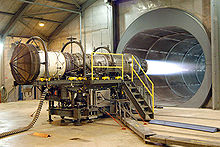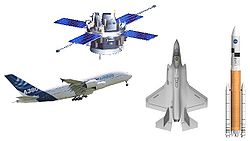- Aerospace engineering
-
Aerospace Engineer 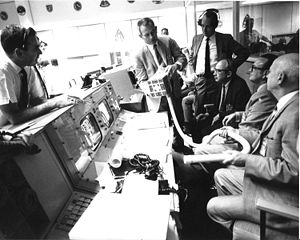
NASA engineers, the ones depicted in the film Apollo 13, worked diligently to protect the lives of the astronauts on the mission.Occupation Names engineer
aerospace engineerActivity sectors aeronautics, astronautics, science Description Competencies technical knowledge, management skills Education required see professional requirements Aerospace engineering is the primary branch of engineering concerned with the design, construction and science of aircraft and spacecraft.[1] It is divided into two major and overlapping branches: aeronautical engineering and astronautical engineering. The former deals with craft that stay within Earth's atmosphere, and the latter with craft that operate outside it.
Aerospace Engineering deals with the design, construction, and application of the science behind the forces and physical properties of aircraft, rockets, flying craft, and spacecraft. The field also covers their aerodynamic characteristics and behaviors, airfoil, control surfaces, lift, drag, and other properties. Aerospace engineering is not to be confused with the various other fields of engineering that go into designing these complex craft. For example, the design of aircraft avionics, while certainly part of the system as a whole, would rather be considered electrical engineering, or perhaps computer engineering. The landing gear system on an aircraft may fall into the field of mechanical engineering, and so forth. It is typically a large combination of many disciplines that makes up aeronautical engineering.
While aeronautical engineering was the original term, the broader "aerospace" has superseded it in usage, as flight technology advanced to include craft operating in outer space.[2] Aerospace engineering, particularly the astronautics branch, is referred to colloquially as "rocket science".
Contents
Overview
Flight vehicles undergo severe conditions such as extreme changes in atmospheric pressure and temperature, with structural loads applied upon vehicle components. Consequently, they are usually the products of various technological and engineering disciplines including aerodynamics, propulsion, avionics, materials science, structural analysis and manufacturing. These technologies are collectively known as aerospace engineering. Because of the complexity of the field, aerospace engineering is conducted by a team of engineers, each specializing in their own branches of science.[3]
The development and manufacturing of a modern flight vehicle is an extremely complex process and demands careful balance and compromise between abilities, design, available technology and costs. Aerospace engineers design, test, and supervise the manufacture of aircraft, spacecraft, and missiles. Aerospace engineers develop new technologies for use in aviation, defense systems, and space.
History
See also: Aviation history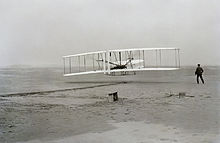 Orville and Wilbur Wright flew the Wright Flyer in 1903 at Kitty Hawk, North Carolina.
Orville and Wilbur Wright flew the Wright Flyer in 1903 at Kitty Hawk, North Carolina.
The origin of aerospace engineering can be traced back to the aviation pioneers around the late 19th century to early 20th centuries, although the work of Sir George Cayley has recently been dated as being from the last decade of the 18th to mid 19th century. One of the most important people in the history of aeronautics,[4] Cayley was a pioneer in aeronautical engineering[5] and is credited as the first person to separate the forces of lift and drag, which are in effect on any flight vehicle.[6] Early knowledge of aeronautical engineering was largely empirical with some concepts and skills imported from other branches of engineering.[7] Scientists understood some key elements of aerospace engineering , like fluid dynamics, in the 18th century. Several years later after the successful flights by the Wright brothers, the 1910s saw the development of aeronautical engineering through the design of World War I military aircraft.
The first definition of aerospace engineering appeared in February 1958.[2] The definition considered the Earth's atmosphere and the outer space as a single realm, thereby encompassing both aircraft (aero) and spacecraft (space) under a newly coined word aerospace. The National Aeronautics and Space Administration was founded in 1958 as a response to the Cold War. United States aerospace engineers launched the first American satellite on January 31, 1958 in response to the USSR launching Sputnik on October 4, 1957.[8]
Elements
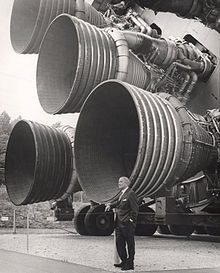 Wernher von Braun, with the F-1 engines of the Saturn V first stage at the US Space and Rocket Center
Wernher von Braun, with the F-1 engines of the Saturn V first stage at the US Space and Rocket Center See also: List of aerospace engineering topics
See also: List of aerospace engineering topicsSome of the elements of aerospace engineering are:[9][10]
- Fluid mechanics – the study of fluid flow around objects. Specifically aerodynamics concerning the flow of air over bodies such as wings or through objects such as wind tunnels (see also lift and aeronautics).
- Astrodynamics – the study of orbital mechanics including prediction of orbital elements when given a select few variables. While few schools in the United States teach this at the undergraduate level, several have graduate programs covering this topic (usually in conjunction with the Physics department of said college or university).
- Statics and Dynamics (engineering mechanics) – the study of movement, forces, moments in mechanical systems.
- Mathematics – in particular, calculus, differential equations, and linear algebra.
- Electrotechnology – the study of electronics within engineering.
- Propulsion – the energy to move a vehicle through the air (or in outer space) is provided by internal combustion engines, jet engines and turbomachinery, or rockets (see also propeller and spacecraft propulsion). A more recent addition to this module is electric propulsion and ion propulsion.
- Control engineering – the study of mathematical modeling of the dynamic behavior of systems and designing them, usually using feedback signals, so that their dynamic behavior is desirable (stable, without large excursions, with minimum error). This applies to the dynamic behavior of aircraft, spacecraft, propulsion systems, and subsystems that exist on aerospace vehicles.
- Aircraft structures – design of the physical configuration of the craft to withstand the forces encountered during flight. Aerospace engineering aims to keep structures lightweight.
- Materials science – related to structures, aerospace engineering also studies the materials of which the aerospace structures are to be built. New materials with very specific properties are invented, or existing ones are modified to improve their performance.
- Solid mechanics – Closely related to material science is solid mechanics which deals with stress and strain analysis of the components of the vehicle. Nowadays there are several Finite Element programs such as MSC Patran/Nastran which aid engineers in the analytical process.
- Aeroelasticity – the interaction of aerodynamic forces and structural flexibility, potentially causing flutter, divergence, etc.
- Avionics – the design and programming of computer systems on board an aircraft or spacecraft and the simulation of systems.
- Software – the specification, design, development, test, and implementation of computer software for aerospace applications, including flight software, ground control software, test & evaluation software, etc.
- Risk and reliability – the study of risk and reliability assessment techniques and the mathematics involved in the quantitative methods.
- Noise control – the study of the mechanics of sound transfer.
- Flight test – designing and executing flight test programs in order to gather and analyze performance and handling qualities data in order to determine if an aircraft meets its design and performance goals and certification requirements.
The basis of most of these elements lies in theoretical mathematics, such as fluid dynamics for aerodynamics or the equations of motion for flight dynamics. There is also a large empirical component. Historically, this empirical component was derived from testing of scale models and prototypes, either in wind tunnels or in the free atmosphere. More recently, advances in computing have enabled the use of computational fluid dynamics to simulate the behavior of fluid, reducing time and expense spent on wind-tunnel testing.
Additionally, aerospace engineering addresses the integration of all components that constitute an aerospace vehicle (subsystems including power, aerospace bearings, communications, thermal control, life support, etc.) and its life cycle (design, temperature, pressure, radiation, velocity, lifetime).
Aerospace engineering degrees
See also: List of aerospace engineering schoolsAerospace engineering may be studied at the advanced diploma, bachelor's, master's, and Ph.D. levels in aerospace engineering departments at many universities, and in mechanical engineering departments at others. A few departments offer degrees in space-focused astronautical engineering. The Delft University of Technology (TU Delft) in the Netherlands offers one of the top European aerospace educational and research platforms, while the programs of the Missouri University of Science and Technology, Rutgers University, and University of Southern California are examples of American schools.[10] In 2009, U.S. News & World Report ranked the undergraduate aerospace engineering programs at the Massachusetts Institute of Technology, Georgia Institute of Technology, and the University of Michigan as the top three best programs at doctorate granting universities in the United States. The other programs in the top ten were Purdue University, California Institute of Technology, University of Maryland, University of Illinois, Stanford University, University of Texas at Austin, and Virginia Tech in that order.[11] The magazine also rates Embry-Riddle Aeronautical University, the United States Air Force Academy, and the United States Naval Academy as the premier aerospace engineering programs at universities that do not grant doctorate degrees.[12] University of Kansas School of Engineering has earned more first and second place AIAA awards than any other academic institution in the world in the 42-year history of the competition.[13] Wichita State University is renowned for its Aerospace Engineering program and also has the third highest research budget for Aerospace Engineering in the United States.[14][15]
In Canada, the University of Toronto has a quality aerospace engineering program. The aerospace program requires the students to go through a competitive program called Engineering Science. The academic program in aerospace science and engineering at U of T includes undergraduate and graduate studies. At the graduate level U of T offers research-intensive programs leading to MASc and PhD degrees, and a professionally-oriented program leading to the MEng degree. The scope of U of T's research includes aeronautical engineering (aircraft flight systems, propulsion, aerodynamics, computational fluid dynamics, and structural mechanics) and space systems engineering (spacecraft dynamics and control, space robotics and mechatronics, and microsatellite technology). Carleton University and Ryerson University are other top aerospace and mechanical engineering universities in Canada which offer accredited graduate and under-graduate degrees.[16][17][18] The Royal Military College of Canada offers an Aerospace engineering degree offered by the Aerospace and Mechanical Engineering Department since 2008. It is a rigorous program with a high amount of additional credits students must earn.[19]
In the UK, Aerospace (or aeronautical) engineering can be studied for the B.Eng., M.Eng., MSc. and Ph.D. levels at a number of universities. The top 10 universities are University of Cambridge, University of Surrey, University of Bristol, University of Southampton, Queens University Belfast, University of Sheffield, Newcastle University, University of Bath, Imperial College London, Loughborough University and University of Nottingham for 2010.[20] The Department of Aeronautics at Imperial College London is noted for providing engineers for the Formula One industry,[21] an industry that uses aerospace technology.
Aerospace can be studied at University of Limerick in Ireland. In Australia, RMIT University offers Aerospace Engineering and has more than 60 years teaching experience in this profession. Monash University, University of New South Wales, University of Sydney, University of Queensland, University of Adelaide and Queensland University of Technology also offers Aerospace Engineering.
European universities that are renowned for their teaching and expertise in aerospace engineering include TU Delft in the Netherlands, ISAE, ENAC, IPSA and ESTACA in France, RWTH Aachen, TU München, the University of Stuttgart, TU Berlin and TU Braunschweig in Germany, and the Centre for Structure Technologies at ETH Zurich in Switzerland. In Austria the FH Joanneum. In Portugal the Instituto Superior Técnico.[22] In Spain the Universidad Politecnica de Madrid, the Universidad Carlos III de Madrid, Universitat Politècnica de Catalunya, Universitat Politècnica de Valencia and University of Seville offer the degree, while in Italy there also several universities where aerospace engineering can be studied including the Politecnico di Torino, the Politecnico di Milano, the University of Pisa, the University of Napoli, the University of Padua and the Sapienza University of Rome. In Eastern Europe they are the Politehnica University of Bucharest in Romania, the University of Belgrade in Serbia, the Warsaw University of Technology and Rzeszów University of Technology in Poland and Brno University of Technology in Brno, Czech Republic.
In India IIT Kanpur possesses its own flight test aircraft and airfield for students in the discipline, while the other IITs also offer degrees in this discipline. IIST Trivandrum,sponsored by ISRO offers undergraduate and post-graduate courses focusing on aeronautics, astronautics and space sciences. Amrita University [23] Coimbatore is another premier institute in private sector that offers Bachelor Degree course in Aerospace Engineering. From academic year 2010 onwards Bengal Engineering and Science University, Shibpur has started offering an undergraduate course Bachelor of Engineering in Aerospace Engineering.University of Petroleum and Energy Studies,Dehradun also one of the leading institute. While in China Nanjing Aeronautics and Astronautics University is a regional leader in the field of aerospace engineering education. In Pakistan Aerospace Engineering can be studied at National University of Sciences and Technology at (CAE), at PAF Academy in Risalpur & at Air University which is Pakistan's only university that grants a Doctorate degree in Aerospace Engineering & Avionics Engineering. In 2002, SUPARCO established IST which is a federally chartered public sector institute of Pakistan offering under graduate and graduate degree in Aerospace Engineering. The MS degree at IST is being offered in collaboration with Beihang University (BUAA), China and Seoul National University, South Korea
Another university that offers Aerospace Engineering degrees (B.Sc, M.Sc, M.Eng, Phd) is the Technion - Israel Institute of Technology, in Israel.
In Brazil the B.Sc, M.Sc and PhD degrees in Aerospace Engineering are offered by the some prestigious Universities like: Universidade de São Paulo - USP at São Carlos campus, Instituto Tecnologico de Aeronautica - ITA and Universidade Federal de Minas Gerais - UFMG. The admission for these courses features among the most difficult in Brazil, partly due to its competitive Vestibular (similar to ACT and SAT in USA).
Popular culture
The term "rocket scientist" is sometimes used to describe a person of great intelligence since "rocket science" is seen as a practice requiring great mental ability, especially technical and mathematical ability. However, the term is a misnomer[24] in that 'science' is the study of nature, whereas 'engineering' encompasses the application of science for the design and manufacturing of vehicles such as rockets and spacecraft.
The term is also used to describe a task or idea as being easy as compared to rocket science, which is perceived as a very difficult field. Usually used as a statement such as "It's not rocket science!"
See also
- American Institute of Aeronautics and Astronautics
- Flight test
- List of aerospace engineering topics
- List of aerospace engineers
- List of Russian aerospace engineers
- Nonequilibrium Gas and Plasma Dynamics Group
- Sigma Gamma Tau (aerospace engineering honor society)
References
- ^ Encyclopedia of Aerospace Engineering. Wiley & Sons. October 2010. ISBN 978-0-470-75440-5.
- ^ a b Stanzione, Kaydon Al (1989). "Engineering". Encyclopedia Britannica. 18 (15 ed.). Chicago. pp. 563–563.
- ^ "Career: Aerospace Engineer". Career Profiles. The Princeton Review. http://www.princetonreview.com/cte/profiles/dayInLife.asp?careerID=5. Retrieved 2006-10-08. "Due to the complexity of the final product, an intricate and rigid organizational structure for production has to be maintained, severely curtailing any single engineer's ability to understand his role as it relates to the final project."
- ^ "Sir George Carley". http://www.flyingmachines.org/cayl.html. Retrieved 2009-07-26. "Sir George Cayley is one of the most important people in the history of aeronautics. Many consider him the first true scientific aerial investigator and the first person to understand the underlying principles and forces of flight."
- ^ "Sir George Carley (British Inventor and Scientist)". Britannica. http://www.britannica.com/EBchecked/topic/100795/Sir-George-Cayley-6th-Baronet. Retrieved 2009-07-26. "English pioneer of aerial navigation and aeronautical engineering and designer of the first successful glider to carry a human being aloft."
- ^ "The Pioneers: Aviation and Airmodelling". http://www.ctie.monash.edu.au/hargrave/cayley.html. Retrieved 2009-07-26. "Sir George Cayley is sometimes called the 'Father of Aviation'. A pioneer in the field, he is credited with the first major breakthrough in heavier-than-air flight. He was the first to identify the four aerodynamic forces of flight – weight, lift, drag, and thrust – and their relationship and also the first to build a successful human carrying glider."
- ^ Kermit Van Every (1988). "Aeronautical engineering". Encyclopedia Americana. 1. Grolier Incorporated.
- ^ A Brief History of NASA
- ^ "Science: Engineering: Aerospace". Open Site. http://open-site.org/Science/Engineering/Aerospace/. Retrieved 2006-10-08.
- ^ a b Gruntman, Mike (September 19, 2007). "The Time for Academic Departments in Astronautical Engineering". AIAA SPACE 2007 Conference & Exposition Agenda. AIAA SPACE 2007 Conference & Exposition. AIAA. http://www.aiaa.org/agenda.cfm?lumeetingid=1808&viewcon=agenda&pageview=2&programSeeview=1&dateget=19-Sep-07&formatview=1.
- ^ America's Best Colleges 2009: Aerospace / Aeronautical / Astronautical (where doctorate is highest degree). USNews.com
- ^ America's Best Colleges 2009: Aerospace / Aeronautical / Astronautical (where doctorate not offered). USNews.com
- ^ [1]
- ^ Youtube.com
- ^ Mentornet.net
- ^ http://www.utias.utoronto.ca/site4.aspx
- ^ http://www.ryerson.ca/aerospace/
- ^ http://www2.carleton.ca/mae/
- ^ http://www.rmc.ca/aca/me-gm/index-eng.asp
- ^ University Rankings League Table 2009
- ^ Grandpix.com: The Imperial College
- ^ IST MSc in Aerospace Engineering
- ^ [2]
- ^ Power To Explore: History of MSFC, p. 226. NASA
External links
- International Journal of Aerospace and Mechanical Engineering
- NDTAeroTech.com, The Online Community for Aerospace NDT Professionals
Academic degrees Associate degree · Foundation degree · Bachelor's degree · Master's degree · Doctoral degree · Professional doctorate · 'Professor' as a degree · Professional degree · Specialist degree · Engineer's degree · Terminal degree · Licentiate · Magister · Diplom · DEACategories:- Aerospace engineering
- Engineering disciplines
Wikimedia Foundation. 2010.

